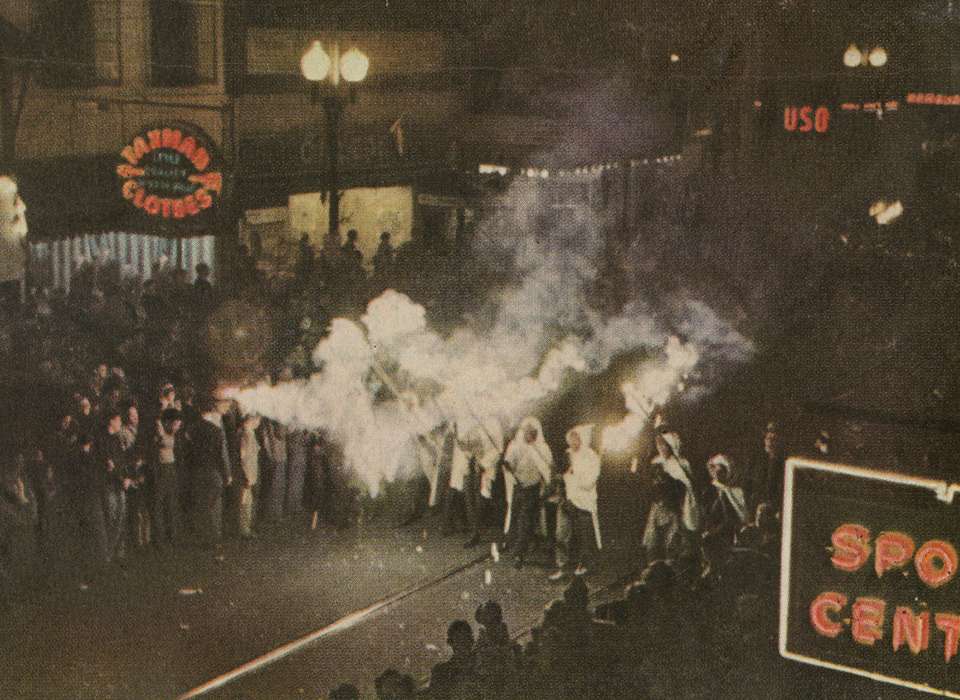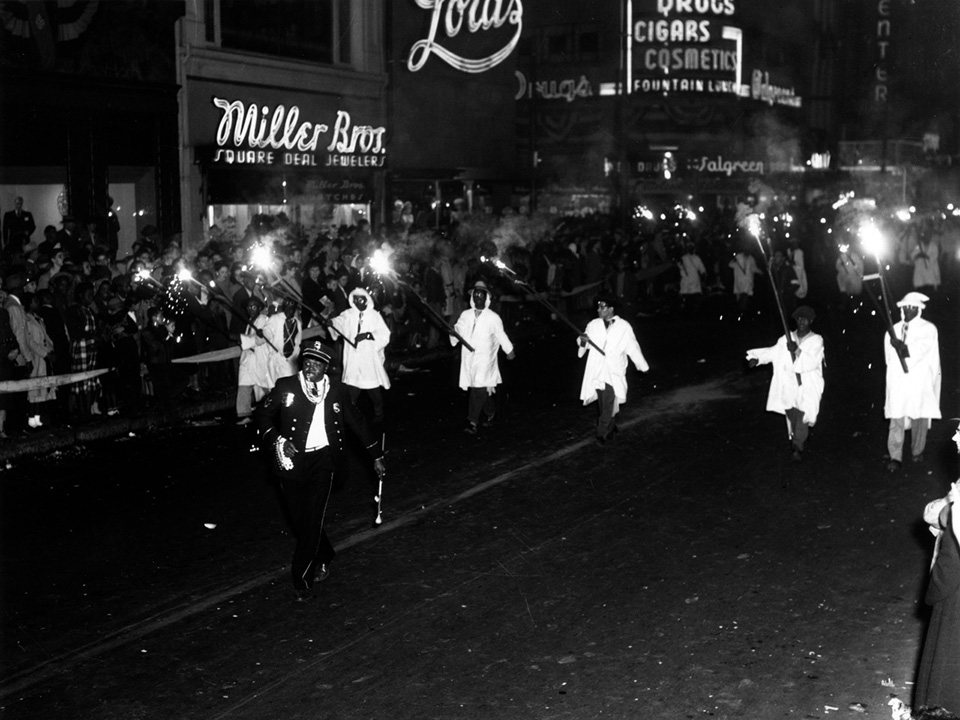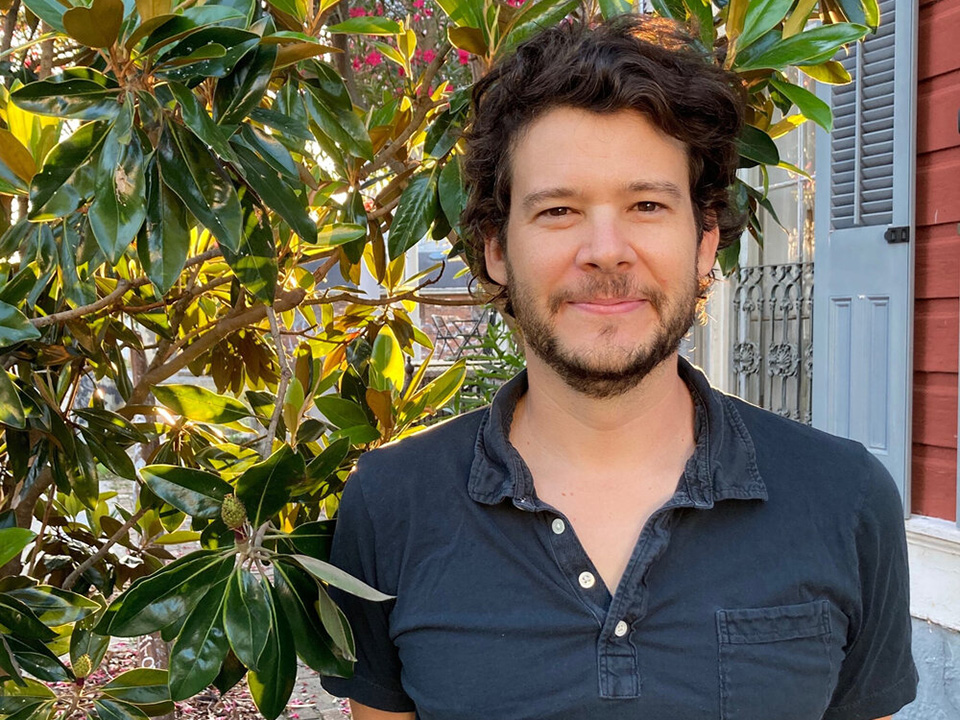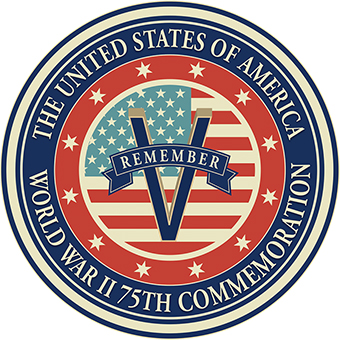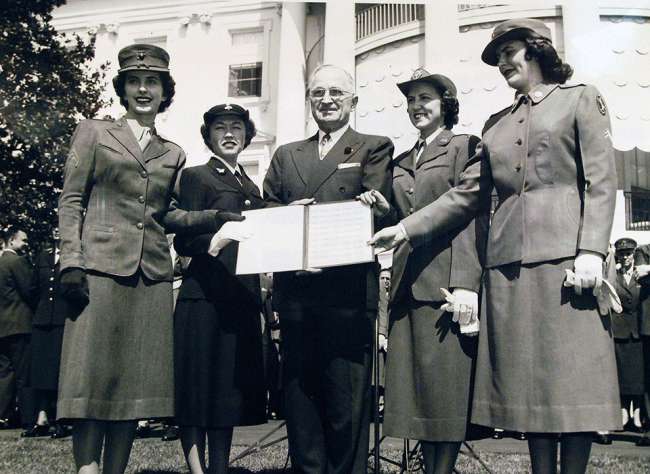Top Image: An illustration featuring flambeaux torch bearers marching in the evening down a street in New Orleans, Louisiana. The Historic New Orleans Collection, 1974.25.19.247.
New Orleans calls them the flambeaux—French for “flaming torches”—the contingent of Black men who carry 70-pound, kerosene-fueled wooden crosses used to illuminate Carnival parade routes. It’s a tradition as old as Mardi Gras itself.
The men dance down the parade route for tips. They buckjump and twirl their torches, to the delight—and fear—of the audience. They make their strenuous walk a competition, a tutorial in improvisation, transforming the parade route into a five-mile soul train, inciting spectators to empty their pockets. They become the center of attention, out-spectacle the spectacle, reinvent the inner workings of Mardi Gras by becoming more carnivalesque than Carnival itself.
View of man leading a marching band in a Mardi Gras parade followed by flambeaux torch bearers. The Charles L. Franck Studio Collection at The Historic New Orleans Collection, 1979.325.3815.
But more importantly, they dance to assert their independence and belonging amidst the city’s segregated Carnival culture. This is dance as resistance. That became most evident in 1946, when Carnival triumphantly returned to New Orleans’s streets after four years of cancelled celebrations due to World War II.
On the Thursday before Mardi Gras, a wage dispute arose between organizers of the Knights of Momus parade and a company of veteran flambeaux carriers. The strikers demanded five dollars per parade, a significant increase from the two dollars they were paid before the war, but a raise they said they had been guaranteed. The krewe captains of three upcoming night parades countered with $2.50 and, in a public address that was front-page news in all three major local newspapers, begged the flambeaux to withdraw their “exorbitant” wage demands. They then appealed to the city’s Black war veterans to mobilize, volunteer their services, and pick up a torch for the good of Carnival, a request met with derision by the Louisiana Weekly, the city’s leading Black periodical. “Momus, god of mockery and rebuke, got a rebuke,” an anonymous editorialist gloated. “It seems that white Carnival parades are having a post-war rude awakening.”
The article went on to quote unnamed Black veterans responding to the captains’ appeal.
“Those white parades are not for colored people,” one man told the Weekly. “We are able to attend because nobody has found out how to control a mob of people by roping off the streets and hanging out ‘white and colored’ signs.”
“Of all the nerve, appealing to veterans,” another protested. “There’s not a place along the parade route where vets’ wives or children can find seats to see parades.” A third called the entire flambeaux history into question: “Who in the h[ell] wants to put on those monkey gowns and clown for people?”
On Friday the Krewe of Hermes marched in the dark, as did the Krewe of Proteus the Monday following, and the most legendary of all parades, the Mistick Krewe of Comus, on Mardi Gras night. After a subsequent strike two years later, the flambeaux eventually received their raise, though the total fell a buck short of the five dollars they were originally promised. Wages gradually increased over time, to the current value of 60 or 80 dollars, plus tips, depending on the parade.
It’s easy to view the flambeaux as a quaint and outmoded vestige of another era (much, if not all, of Mardi Gras could be deemed long overdue for disposal on history’s trash heap). The tradition might be seen as reinforcing racist stereotypes, specifically that of the content and faithful Black man performing for the entertainment of whites. While arguing for its abandonment, one Black community activist has referred to the flambeaux as “carrying the torch of oppression.”
It’s true that only the rare New Orleanian can name a veteran flambeaux, which is certainly not the case for other figurative torchbearers of local Black culture—the politicians, musicians, and Second Line club members. The flambeaux, however, remain largely anonymous, socially invisible, unembraced. Over the decades, Mardi Gras parades have phased out traditional flambeaux torches, opting for modernized lighting. Their ranks have been gentrified. The work they do is dangerous—men get hurt.
But the flambeaux I’ve interviewed see themselves as an important and indelible facet of Carnival culture. They inherit their crosses from a father or uncle, older brother or cousin. They speak of family lineages, of inheriting the stick, of teaching the younger generation how to dance in time with the music and the flame: a literal passing of the torch. Some call themselves the “Keepers of the Light.”
For more information on the 1946 Flambeaux Strike, visit Paper Monuments.
Meet the Author
Rien Fertel is a Louisiana-born and based freelance writer. He has written for Time Magazine, The Wall Street Journal, the Oxford American, Garden & Gun, Men's Journal, The A.V. Club, Pacific Standard, Southern Living, Saveur, The Local Palate, and many other print and online publications.
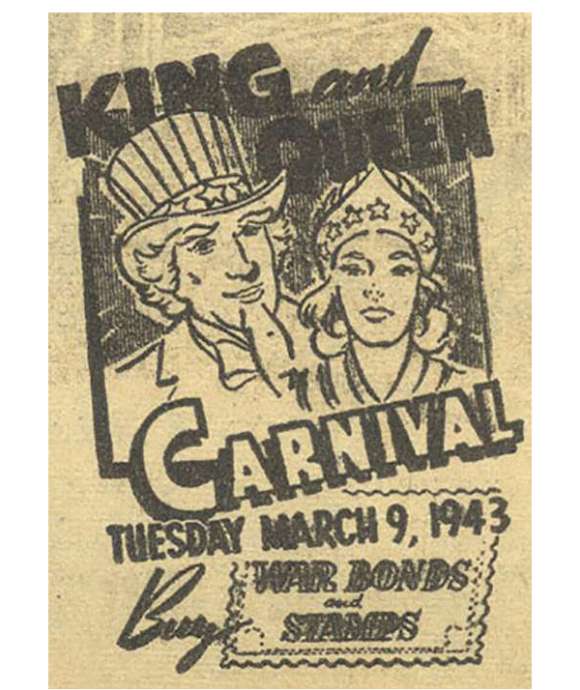
Mardi Gras: Canceled for the Duration
In the four years of war, Americans on the home front were asked to do their part and to go without certain items for the sake of the war effort. For residents of New Orleans, World War II also meant going without Mardi Gras.
This article is part of a series commemorating the 75th anniversary of the end of World War II made possible by the Department of Defense.
Cite this article:
MLA Citation:
APA Citation:
Chicago Style Citation:
